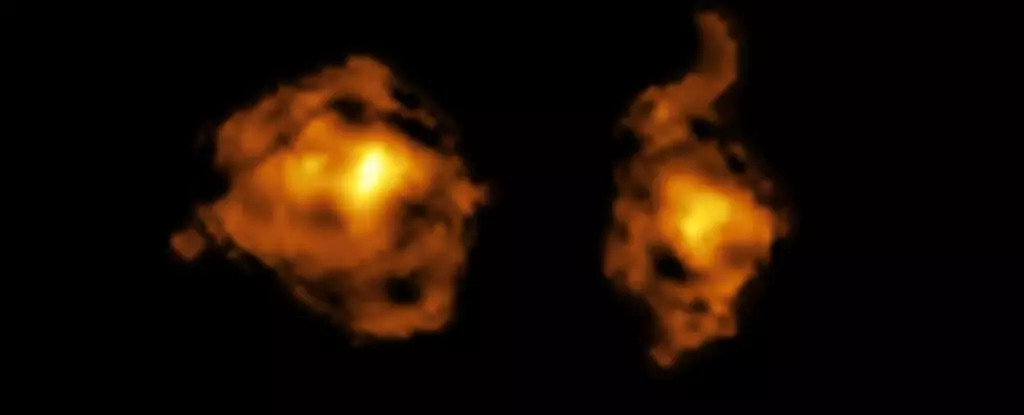In the grand theater of the cosmos, galaxies are not merely passive entities; they are vibrant participants in a complex ballet of interactions that can lead to astonishing results. Recent observations have revealed a dramatic phenomenon dubbed the “cosmic joust,” where two galaxies engage in a captivating collision that has profound implications for their evolution. At the heart of this spectacle is a supermassive black hole, a quasar, whose fiery radiation radically influences the dynamics of both the colliding galaxies.
Researchers led by astronomer Sergei Balashev from the Ioffe Institute in Russia initially uncovered this extraordinary event, signaling an unprecedented opportunity for scientists to understand the intricate interplay between galactic structures amidst a collision. The findings highlight the essential nature of these galactic interactions as they shed light on stellar evolution. Unlike mere celestial bodies swirling in isolation, galaxies are interconnected in a web of gravitational dynamics, constantly reshaping one another.
The Mechanism of Galactic Interaction
When galaxies collide, the forces at play are incredibly complex, yet they can be understood as a dance dictated by gravity. In the case of the cosmic joust, one of the competing galaxies is a quasar, a state that emerges when the supermassive black hole engages in a cataclysmic feeding frenzy, consuming vast amounts of material. This chaotic accretion process not only generates enormous energy but also leads to jets of radiation that can physically impact nearby galaxies. At speeds nearing 500 kilometers per second, the quasar’s jets blast into its counterpart, unleashing a tsunami of radiation and matter that disrupts star-forming regions in the opposing galaxy.
This disruption isn’t merely a destructive force; rather, it serves as a critical moment in cosmic evolution. The jets effectively clear away the dust and gas clouds that are the building blocks for new stars, significantly inhibiting star formation in the wounded galaxy. As these clouds dissipate under the onslaught of radiation, the delicate balance that allows for stellar birth is profoundly altered.
The Duality of Cosmic Destruction and Creation
As with many natural processes, the cosmic joust encapsulates a duality: destruction and creation. While the radiation jet from the quasar decimates the gas clouds in the afflicted galaxy, it simultaneously may lead to a regeneration of stellar activity in the larger context of the galactic collision. This remarkable paradox underscores the inherent resilience of galactic systems. In the midst of turmoil, moments are generated where the merging gases clash and coalesce, giving rise to regions of higher density primed for new star formation.
Furthermore, the gravitational dynamics at work mean that some of the ‘wounded’ galaxy’s gas is siphoned off and absorbed by the quasar itself, contributing additional fuel to the ravenous black hole. The black hole is not only a destructive force but also a catalyst for its own growth, paradoxically feeding on the fallout of the cosmic joust. The interconnectedness of destruction and growth accentuates the narrative of galactic evolution, positioning it as a continual process of birth, death, and rebirth within the celestial realm.
Implications for Understanding Galactic Evolution
The “cosmic joust” significantly alters our comprehension of how galaxies evolve over immense timescales. The interconnectedness between galaxies suggests that our Universe is far from a collection of isolated giant masses; instead, it is an enduring, dynamic system shaped by gravitational interactions. Each collision and merger leads to new configurations that redefine what we understand about star formation and black hole activity.
By studying such cataclysmic events, we glean insights not only into individual cosmic structures but also into the broader mechanisms driving the evolutionary narrative of our Universe. The study of these dynamic interactions could rewrite chapters on galactic formation, influencing theories of dark matter’s role and the future trajectory of galaxies. Moreover, exploring the implications of such an event pushes us to confront the very nature of life, creation, and the balance of cosmic destruction that facilitates new beginnings.
As humanity continues to gaze into the vastness of space, the ongoing revelations about such stunning celestial episodes invite us to ponder our place in this intricate cosmic dance, where even destruction plays an essential role in the narrative of existence.


Leave a Reply